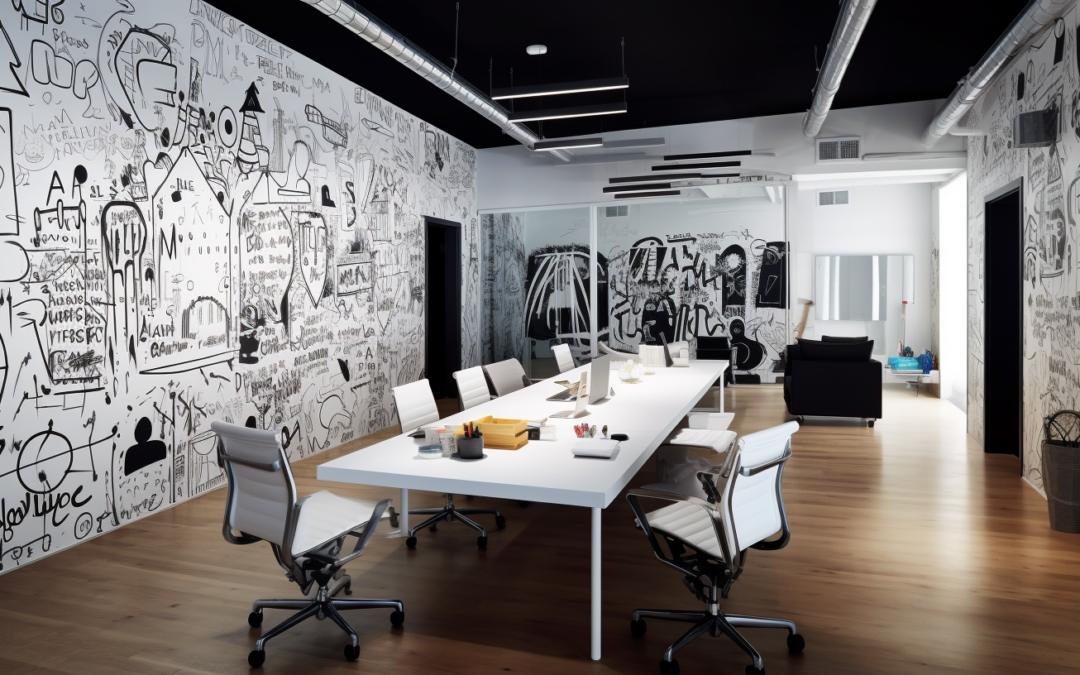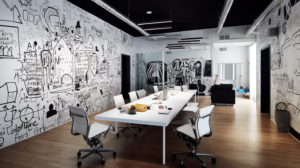Reducing Waste in Conference Rooms with Commercial Dry Erase Wall Paint
In the corporate sphere, organizations endeavor to lessen their ecological impact and solidify their standing as responsible members of society. Commercial dry erase wall paint has emerged as a groundbreaking choice. These adaptable surfaces are not only reshaping how we collaborate and work but also significantly diminish paper waste and encourage eco-friendly office environments.
As the corporate world strives for more sustainable practices, one area of focus is conference rooms, which have traditionally been a source of substantial paper waste due to printed materials, sticky notes, and flipcharts. However, progressive organizations are taking a different approach by integrating commercial dry erase paint into their conference room designs. This article explores how this eco-friendly solution is helping businesses reduce waste, enhance collaboration, and champion sustainability within their conference spaces.
The Eco-Friendly Evolution of Conference Rooms
Traditional conference rooms were once synonymous with paper-heavy meetings, where agendas, notes, and brainstorming sessions were conducted using reams of paper. But as environmental awareness grows, businesses are reimagining their conference spaces as eco-friendly hubs that minimize paper consumption.
By applying commercial dry erase wall paint to the surfaces of conference rooms, companies are eliminating the need for disposable materials. These painted walls serve as expansive, reusable canvases where meeting participants can jot down ideas, make notes, and sketch out plans. Everything is digitized onto the walls, reducing paper waste and environmental impact.
Streamlining Collaborative Sessions
One of the key advantages of commercial dry erase paint in conference rooms is its ability to streamline collaborative sessions. These surfaces encourage spontaneous idea generation and free-flowing discussions, as participants can write, draw, and erase in real time. This fluid approach to collaboration enhances creativity and promotes a more efficient use of meeting time.
Imagine a team gathering in a conference room for a brainstorming session. Instead of distributing paper handouts or sticky notes, participants pick up dry erase markers and start writing directly on the walls. Ideas are mapped out, discussed, and refined on the painted surface, eliminating the need for piles of paper materials that might ultimately end up in the recycling bin.
Promoting Sustainable Meetings
Sustainable conference spaces aren’t just about reducing paper waste; they also encompass energy-efficient lighting, eco-conscious furniture choices, and responsible resource management. Commercial dry erase wall paint aligns perfectly with this holistic approach to sustainability. These painted walls contribute to more energy-efficient meetings by reducing the need for excessive lighting due to enhanced visibility provided by the bright, white surfaces.
Moreover, organizations providing sustainable conference spaces sends a powerful message to their employees, clients, and partners. Such an initiative indicates the company’s dedication to responsible business practices. By incorporating eco-friendly elements into their conference rooms, they showcase their commitment to sustainability, creating an atmosphere encouraging innovation and forward-thinking ideas.
Empowering Visual Merchandising
In the ever-evolving retail landscape, visual merchandising has emerged as an art form that blends creativity and marketing. Eye-catching displays that evoke emotion and tell a story require artisans to utilize signage, paper tags, and static displays masterfully. Yet, as technology evolves, more tools are at the disposal of retailers, allowing visual merchandisers to drive impactful brand experiences and engage with customers in unprecedented ways.
Enter commercial dry erase wall paint. This innovative solution is changing the way retailers approach visual merchandising. By transforming walls into interactive canvases, it allows for dynamic, ever-evolving displays. With a marker stroke, retail employees can update prices, highlight promotions, or even sketch custom designs to match the season or a specific theme.
This adaptability is especially valuable in an industry where change is constant—in the past, updating a display required hours of work, printing new signage, and carefully positioning each element. Now, it’s as simple as erasing the old and drawing in the new. This saves time and reduces paper waste and printing costs, aligning perfectly with sustainable retail practices.
Enhancing Store Layouts
Retailers are also discovering that commercial dry erase paint is a valuable tool for improving store layouts. Whether planning a new arrangement or making adjustments on the fly, having writable walls can streamline the process.
Imagine a clothing boutique that wants to experiment with different clothing displays. Instead of physically moving racks and mannequins, employees can sketch out new layouts directly on the walls. This visual aid allows for more informed decisions, ensuring the final layout is aesthetically pleasing and functional.
Moreover, this approach facilitates collaboration among team members. Employees can share their ideas and adjustments in real time, fostering a sense of teamwork and creativity. It’s a practical example of how technology and sustainability can work hand in hand to improve retail operations.
Real-World Benefits: Case Studies
Let’s delve into real-world examples of how businesses are successfully incorporating commercial dry erase wall paint into their conference rooms and beyond:
The Progressive Tech Company: A forward-thinking tech company revamped its conference rooms with commercial dry erase paint. The result was a significant reduction in paper waste and a boost in meeting efficiency. Employees found the new interactive surfaces invigorating and reported greater collaboration during meetings.
The Sustainable Law Firm: A law firm known for its commitment to sustainability introduced commercial dry erase wall paint to its conference rooms. The transition not only reduced paper consumption but also improved the firm’s image among clients who appreciated the eco-friendly approach. The walls served as practical tools for visualizing complex legal concepts during discussions.
The Eco-Conscious Nonprofit: An environmental nonprofit took its commitment to sustainability to the next level by incorporating dry erase wall paint throughout its office, including its conference spaces. This initiative aligned with the organization’s mission and inspired staff to adopt eco-friendly practices in all aspects of their work.
Practical Tips for Implementing Commercial Dry Erase Wall Paint
Integrating dry erase wall paint into your conference rooms is a strategic move towards sustainability and efficiency. To make this transition as seamless and effective as possible, consider the following practical tips:
1. Comprehensive Surface Preparation: Meticulous surface preparation is essential before applying dry erase wall paint. Ensure that the walls are thoroughly cleaned and smoothed. Any imperfections on the wall’s surface can affect the paint’s erasability. A smooth canvas is vital to getting the most out of your dry erase wall.
2. Invest in Quality Materials: Prioritize quality when selecting commercial dry erase paint. Opt for products known for their durability and longevity. High-quality paints last longer and provide a smoother, more erasable surface, ensuring your investment pays off in the long run.
3. Strategic Placement: Identifying the ideal locations for your painted walls within the conference room is vital. Consider where participants typically gather for brainstorming and note-taking. These are the areas where dry erase walls will be most effective. Placing them at eye level or within easy reach ensures everyone can contribute seamlessly during meetings.
4. Regular Maintenance: Like any other part of your office, commercial dry erase walls require regular maintenance to preserve their erasability and appearance. Encourage a routine cleaning schedule to remove marks, ensuring your walls remain blank for ideas. Choose non-abrasive cleaners to protect the surface.
5. Employee Training: To maximize the benefits of commercial dry erase wall paint, provide employees with proper training on how to use these surfaces effectively during meetings and collaborative sessions. Educate them on techniques for clear writing, efficient erasing, and using different colors for visual clarity. By empowering your team with the knowledge of how to leverage dry erase walls effectively, you’ll enhance the overall meeting experience.
6. Promote Environmental Education: Beyond the practicalities, it’s crucial to instill an understanding of the environmental benefits associated with commercial dry erase wall paint among your employees. Encourage them to embrace sustainable meeting practices by emphasizing how this eco-friendly solution reduces paper waste and aligns with your organization’s broader sustainability goals.
By following these practical tips, your organization can make the most of dry erase wall paint in your conference rooms, contributing to a greener and more efficient future for your meetings and business operations.
Sustainable Conference Rooms for a Greener Future
In summary, businesses increasingly recognize the potential of commercial dry erase wall paint to create sustainable conference spaces that reduce paper waste and promote eco-friendly meetings. These innovative surfaces transform traditional conference rooms into dynamic hubs of creativity and collaboration, inspire employees, and send a powerful message about the organization’s commitment to sustainability.
As organizations strive to meet their environmental responsibilities and enhance the efficiency of their meetings, dry erase paint is poised to play a crucial role in shaping the future of conference spaces. By adopting this eco-friendly solution, businesses can contribute to a greener, more sustainable future while reaping the practical benefits of enhanced collaboration and productivity in their meetings.



Recent Comments